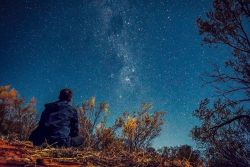The Opal capital of the world
Coober Pedy calls itself the Opal Capital of the world and is actually the largest source of these gems. About three quarters of all white opals worldwide are found in the vicinity of Coober Pedy. Since 1916 they have been mined here. The extreme summer temperatures caused that most of the nearly 1700 inhabitants live in underground dugouts. Originally they were dug by hand into the clayey earth or blasted into the rock, but now these caves are being cut out of the earth or expanded by tunneling machines within a very short time. The entrances are mostly above ground to the side of the road and the actual living area is located in earth mounds behind.
Located in the Outback, it is hundreds of kilometers from the nearest settlement. Today the city also lives from tourists who visit former opal mines, the cemetery and the underground churches.
Annoying Aborigine ruined my sleep
Around 7 pm I took the night bus to the Australian outback. My Russian friend recommended me to stop in Coober Pedy, as it is quite unique in the world. In the small village there is only one hostel, which is expensive with 40 AU$ per night. It claims to be the only hostel where you can stay underground. In the bus I met the Japanese girl Kyoka. We both were the only hostel guests. Sleeping was impossible during the 11-hour trip, because the Aborigine behind me was always screaming - either with his sister who was sitting in the front of the bus or on the phone. He also reeked of alcohol and cigarettes. It was the first impression I got from the native Australians. In the village there is even an advertising sign for alcohol rehab programs especially for Aborigines from which many are addicted to alcohol.
Underground hostel like in a horror movie
Shortly before 6 am I could finally get off the bus and we rang the doorbell of the hostel. Like in a horror movie an elderly gentleman greeted us with a smoky voice and his smile revealed that already half of his teeth had fallen out. He gave us the code to enter the hostel building that was behind the parking lot. We descended into the dark rooms. Both of us got beds in different rooms, so we each had a room for ourselves. The "rooms" did not even have doors, but were "shut" with curtains. So you could hear every snorer or fart of the neighbouring rooms, many of which were also occupied by hotel guests.
A Serbian Orthodox Underground Church in the middle of Nowhere
We lay down for a short time, because we both had hardly gotten any sleep during the long bus ride. When we were about to choose the places we wanted to visit, we noticed that many spots were too far away for pedestrians. Without a car we struggled a little bit. So we had to concentrate on the places that could be reached on foot and first walked to the town sign. We had to be careful not to deviate too far from the road, because everywhere signs warned against falling into abandoned mine holes. We were both amazed when we saw a signpost for a Serbian Orthodox Church. A few years ago a Serbian priest actually built such a church underground in the middle of the Australian outback. It is really in good condition and that although there was not a single staff member there. Also the Anglican church we visited was totally empty.
Hot, dry, dusty, empty & dozens of flies
We walked back to the main street of the village. Also here almost no inhabitant walked around outside. It is understandable. During the day a lot of annoying flies are chasing you. The air is terribly dusty and dry. Hardly any plants grow. Even now in "winter" you are grilled by the sun at noon. In summer, when the temperatures here reach more than 40° C, it is better not to be here or you will always stay underground like the inhabitants here. Almost every second house either sells opal stones or offers accommodation underground. When we got hungry, we looked for a restaurant. We did not have to search for a long time, as there is actually only one in the whole village. It was a pizzeria at which even kangaroo or emu pizza appeared on the menu.
After our lunch we walked to a small hill where the first tree of the city is located. Strangely enough, it was made of metal and not of wood. In the evening we watched our first sunset over the outback on another hill. Already the next morning I moved on further into the Australian outback.

